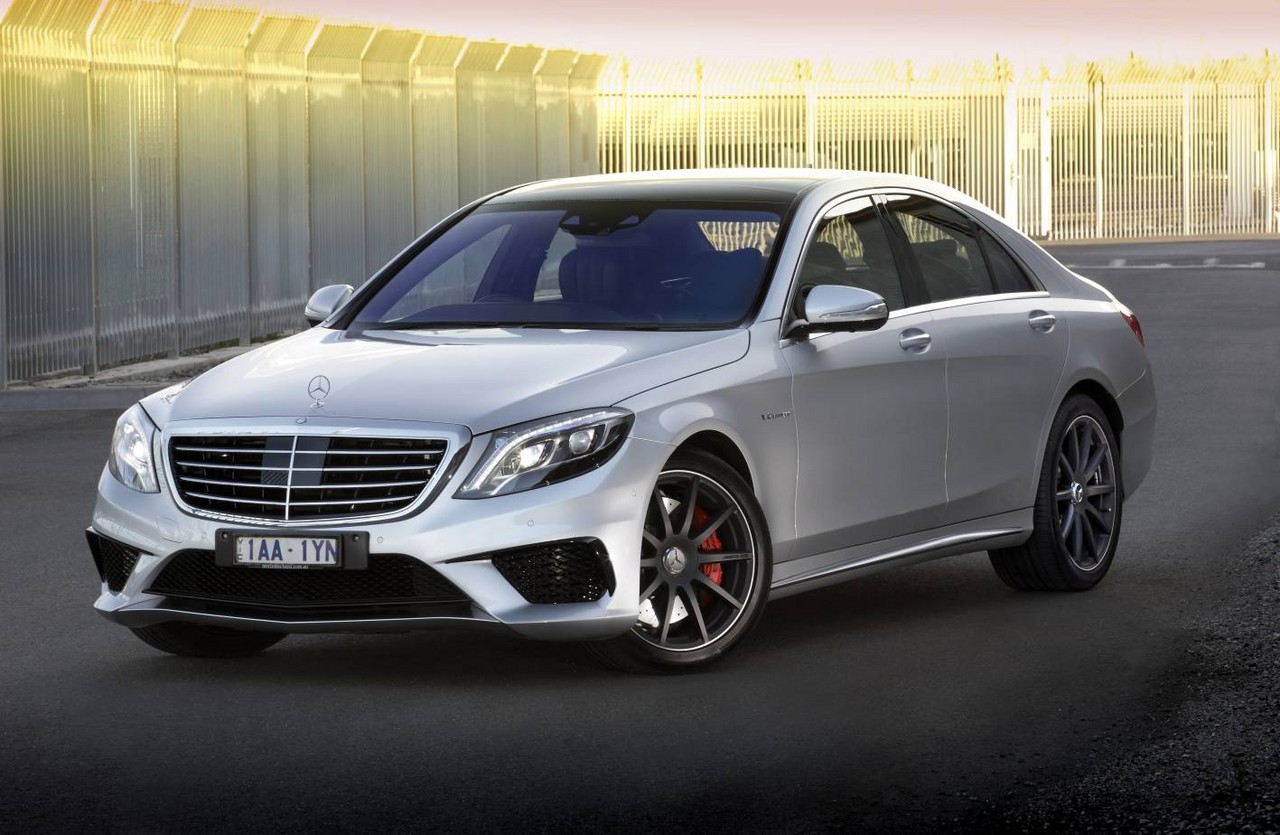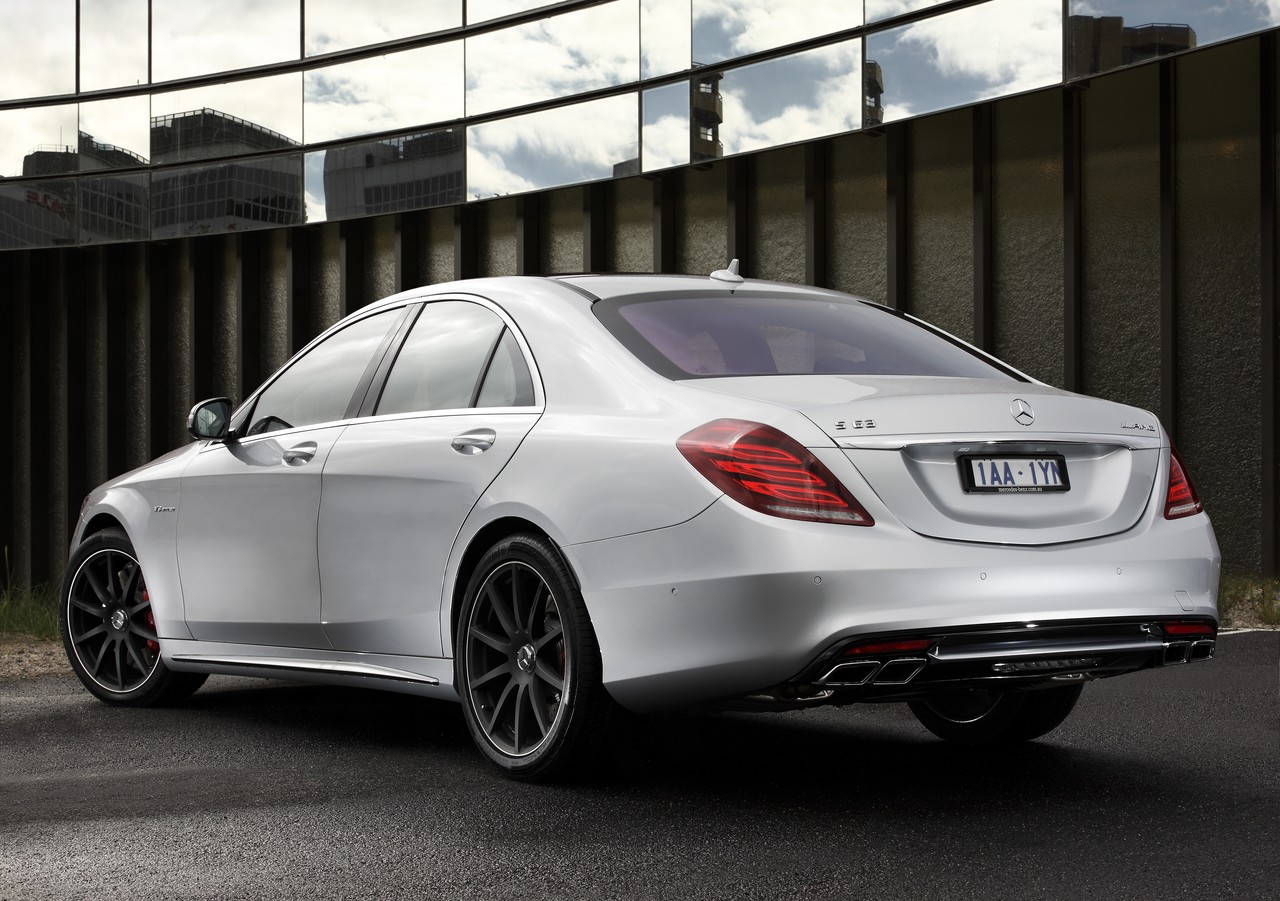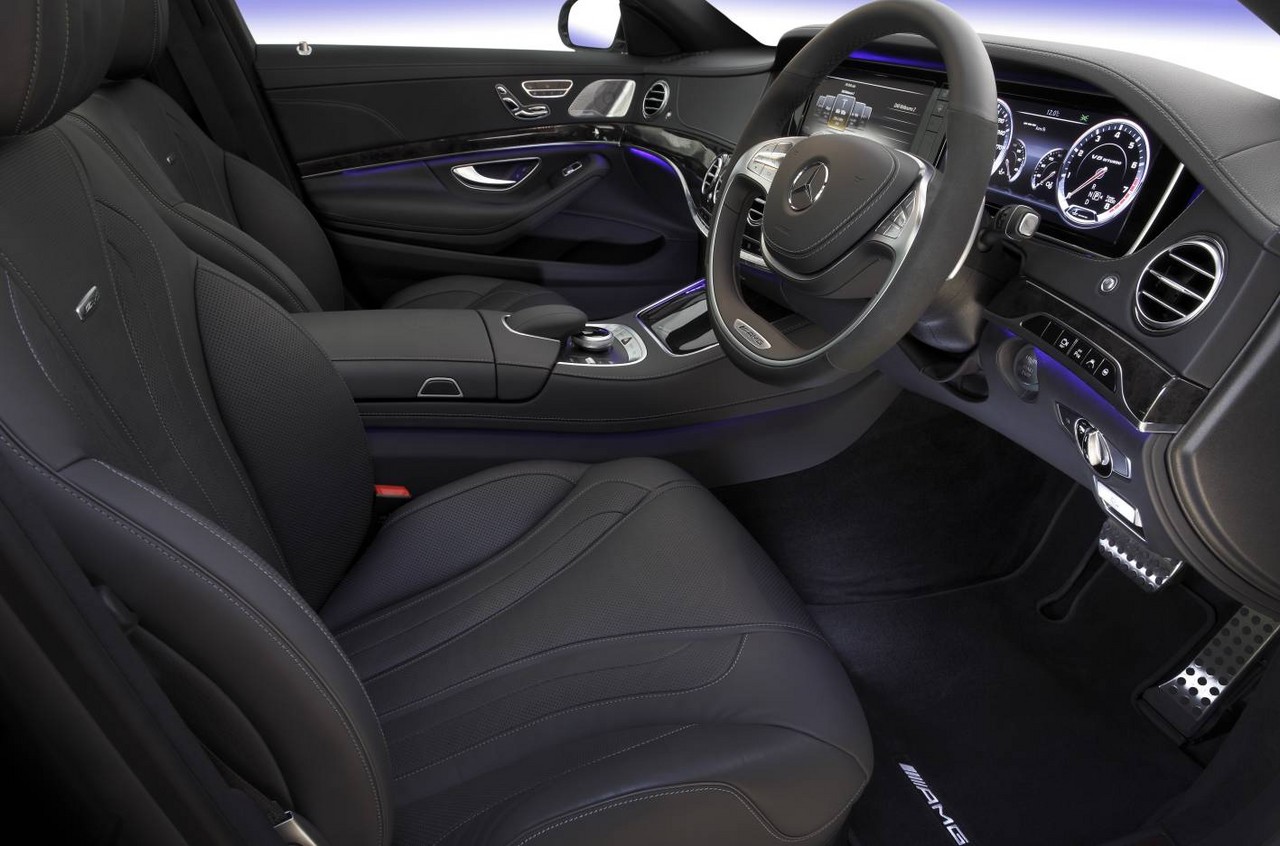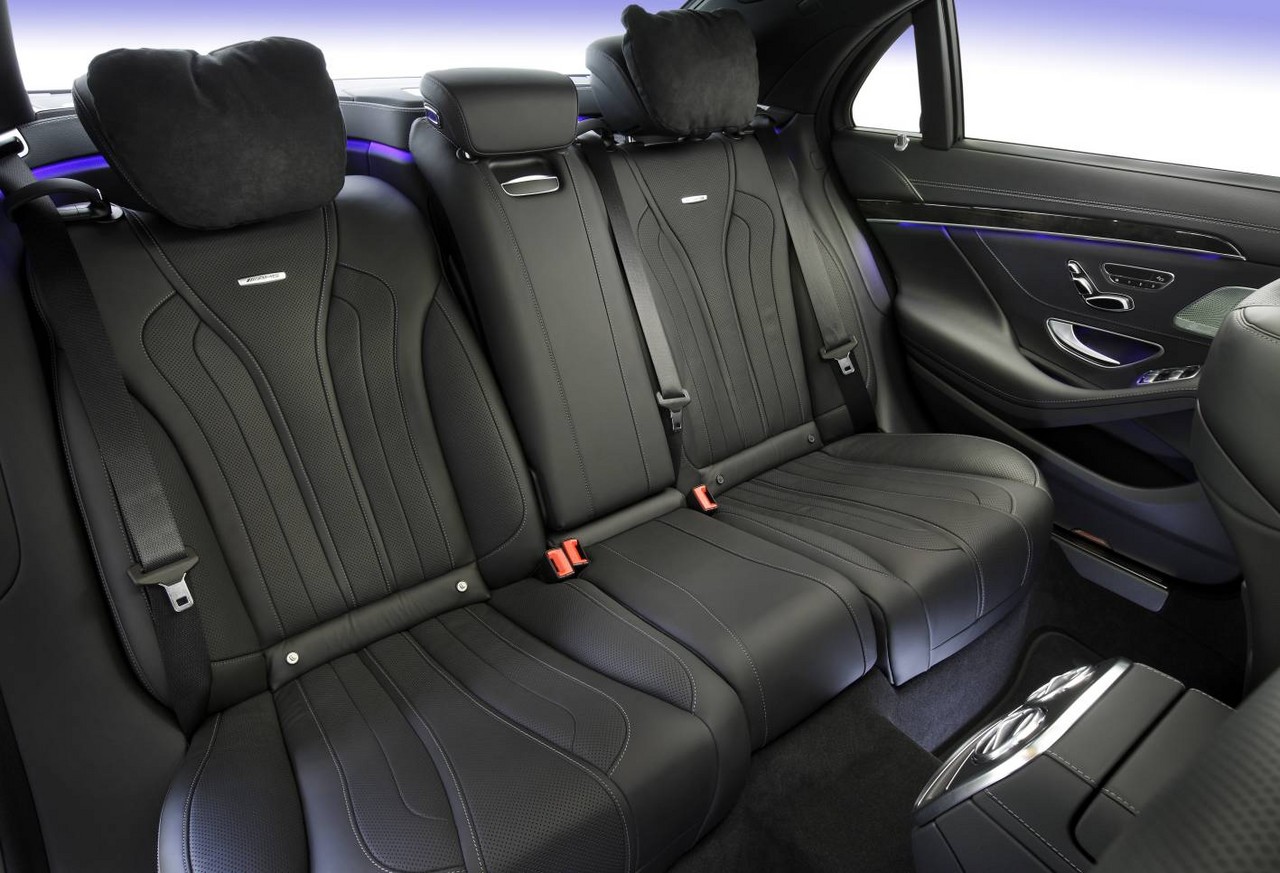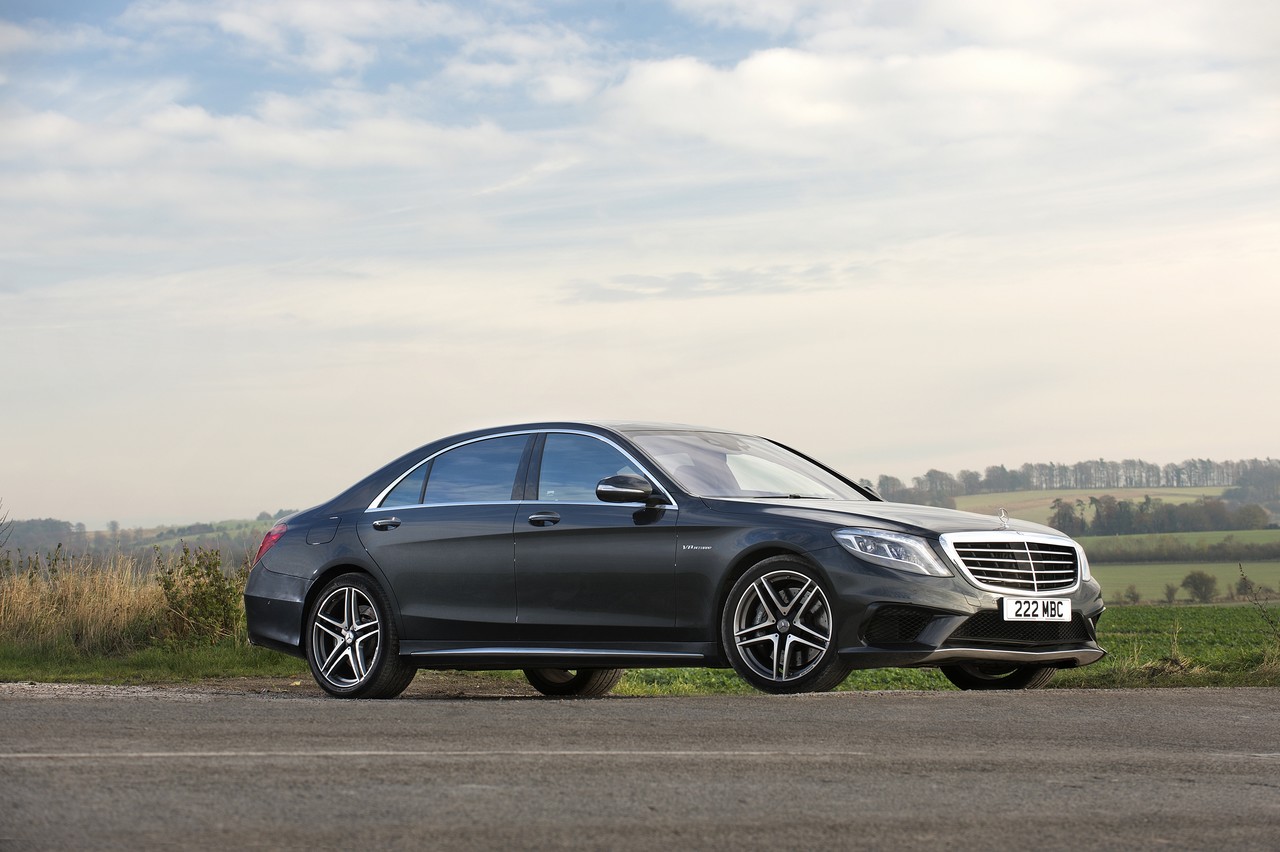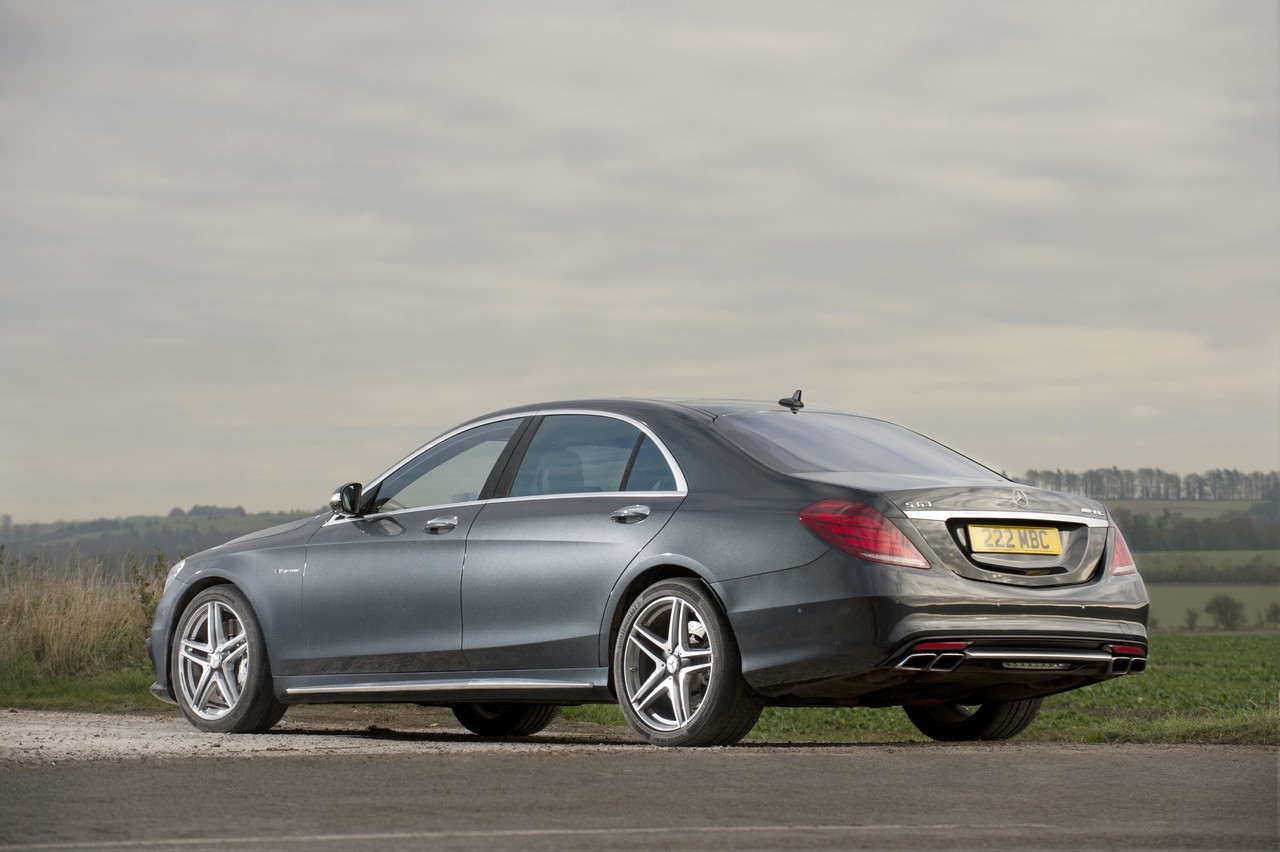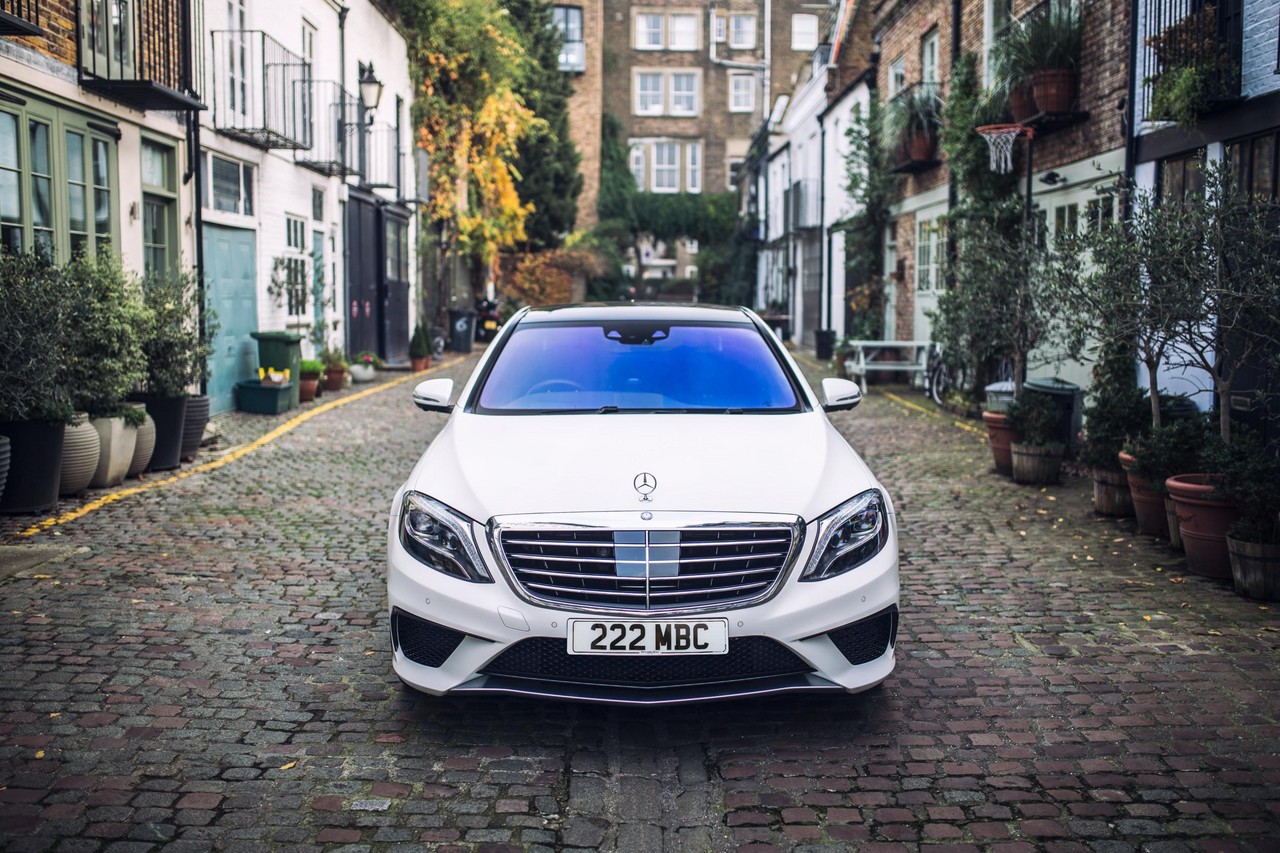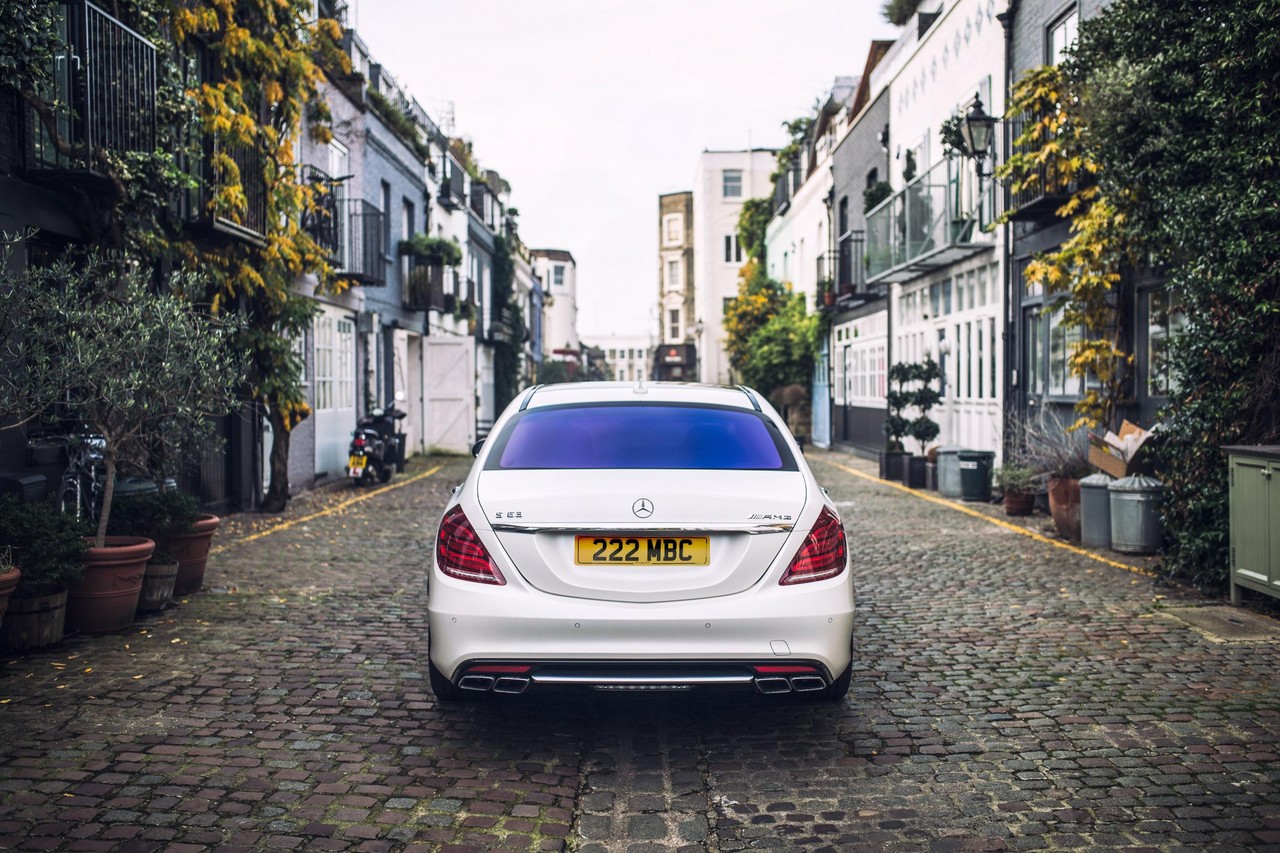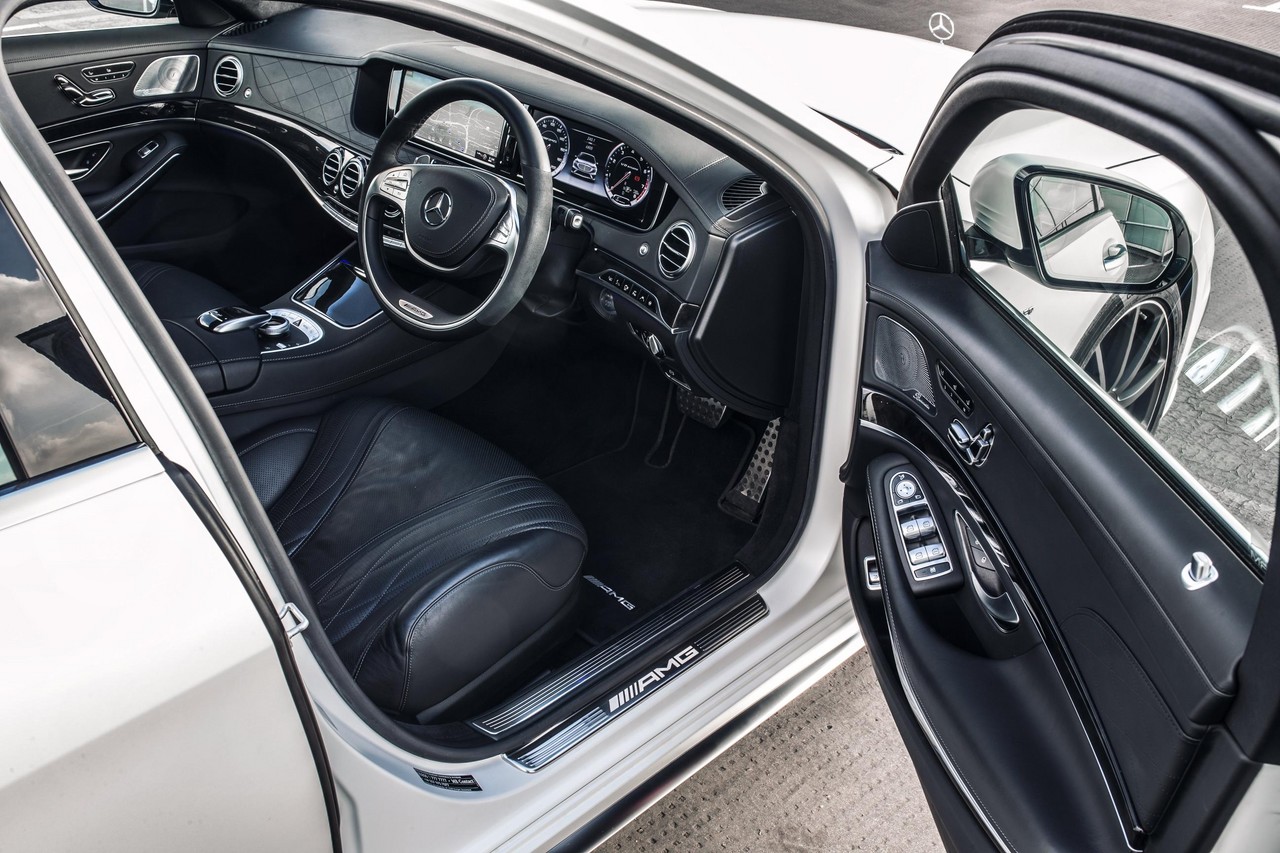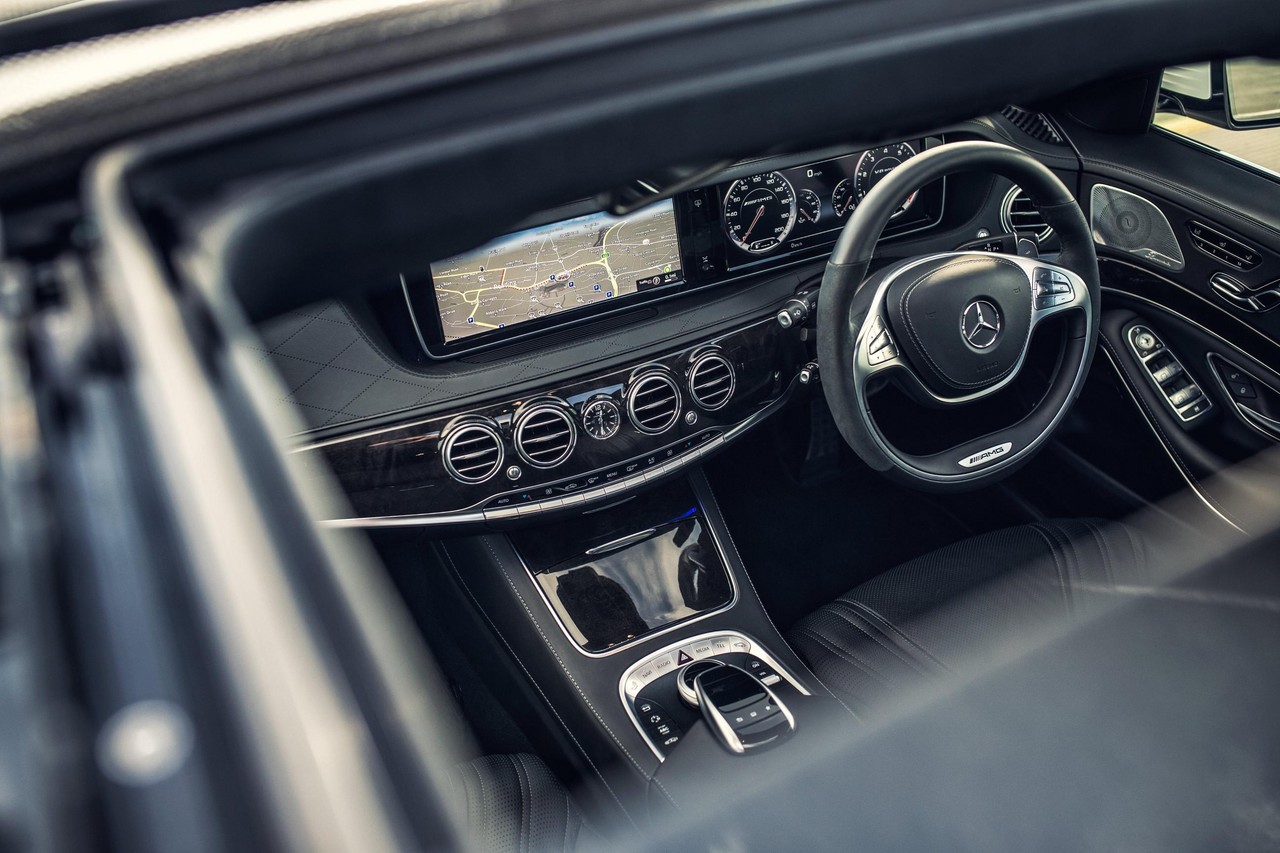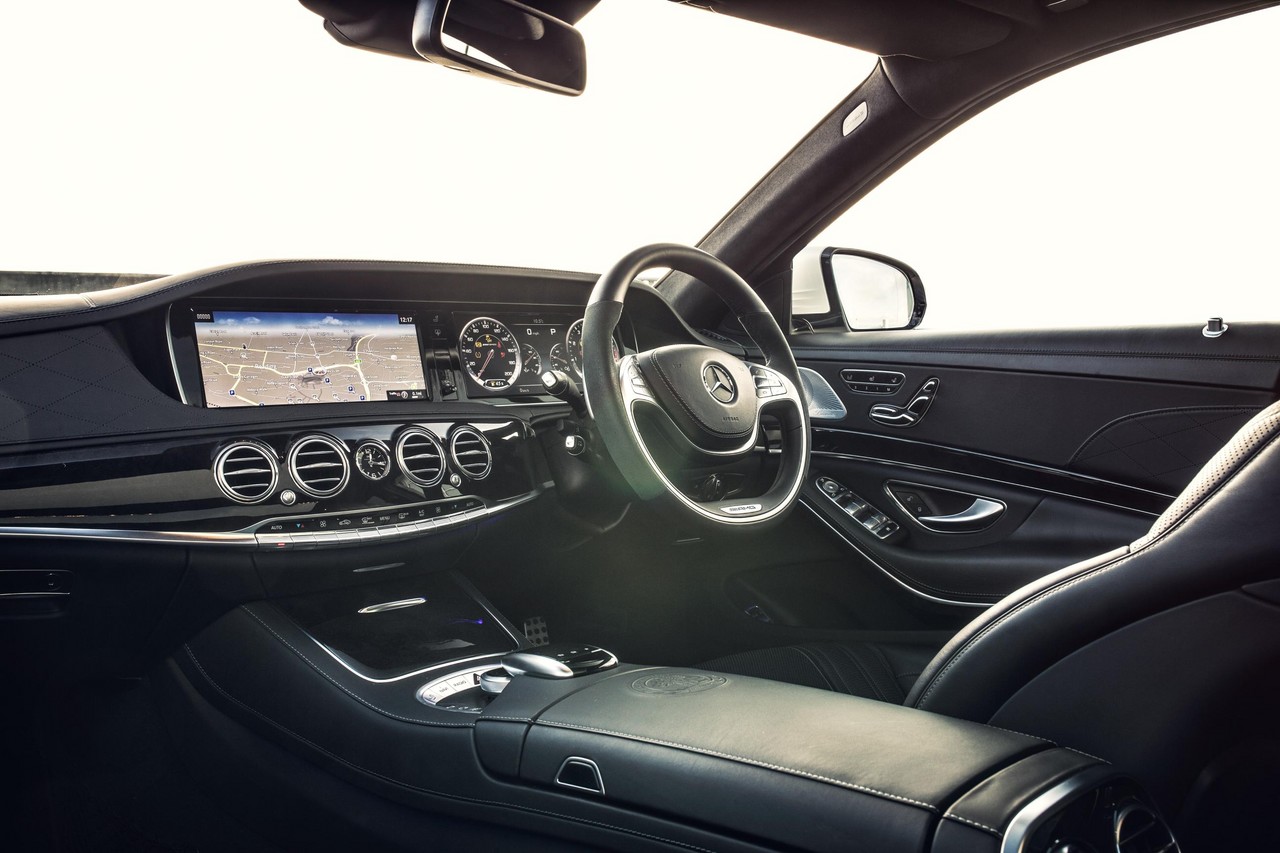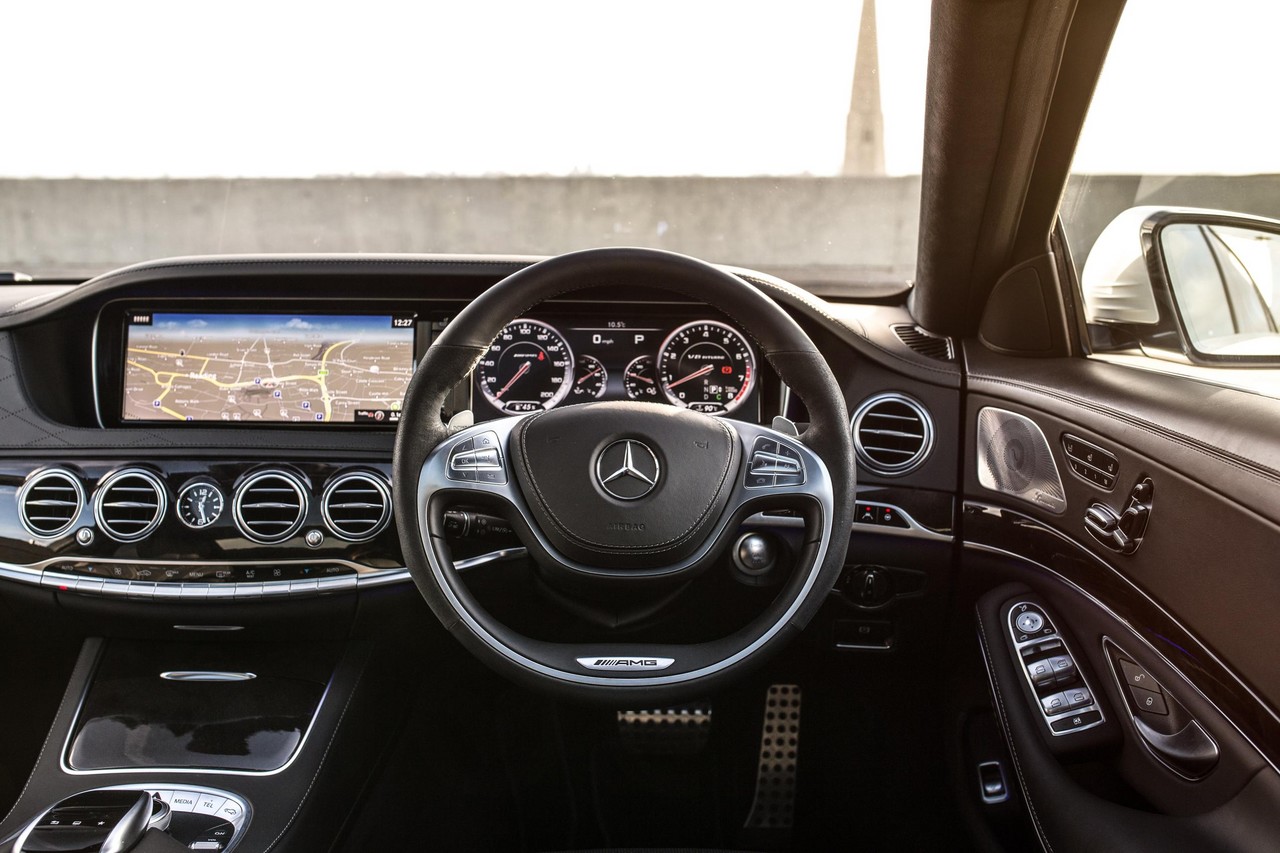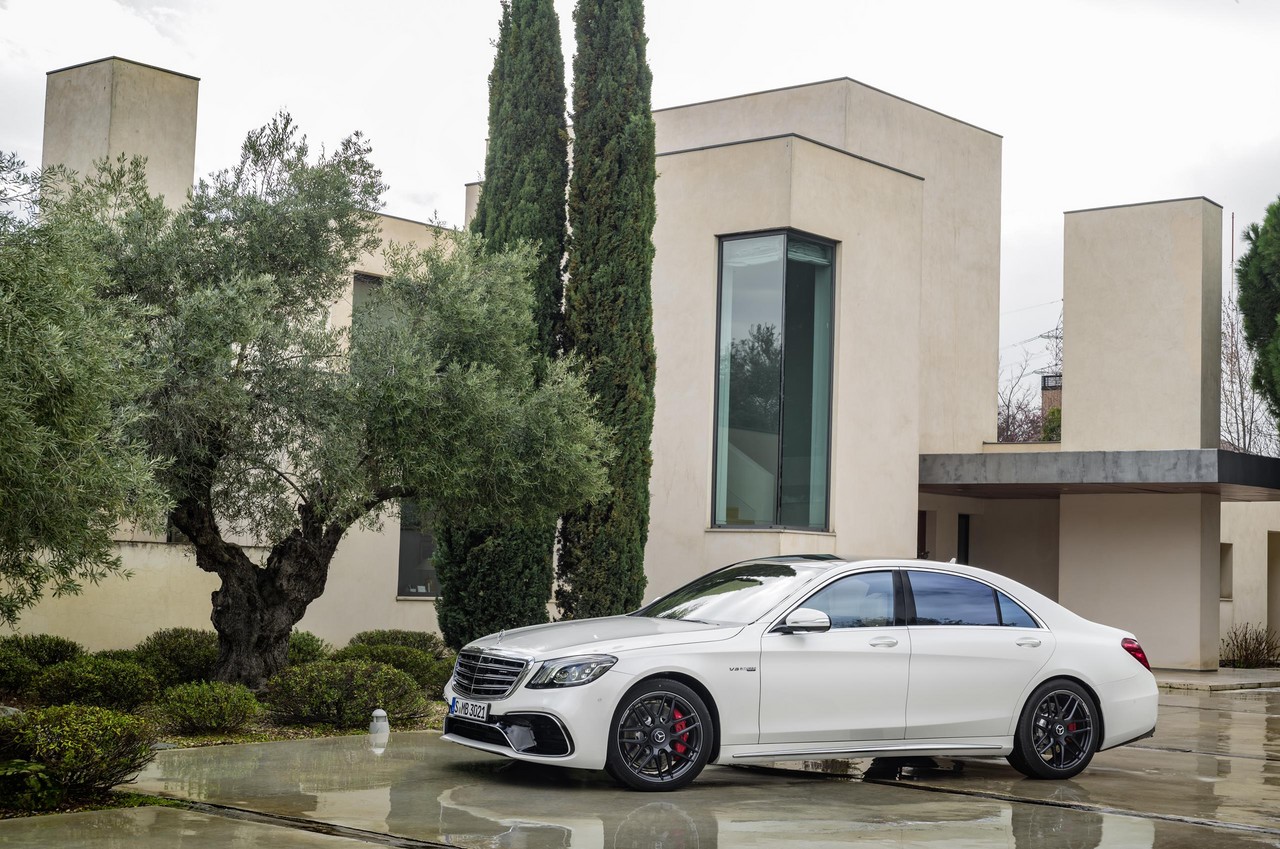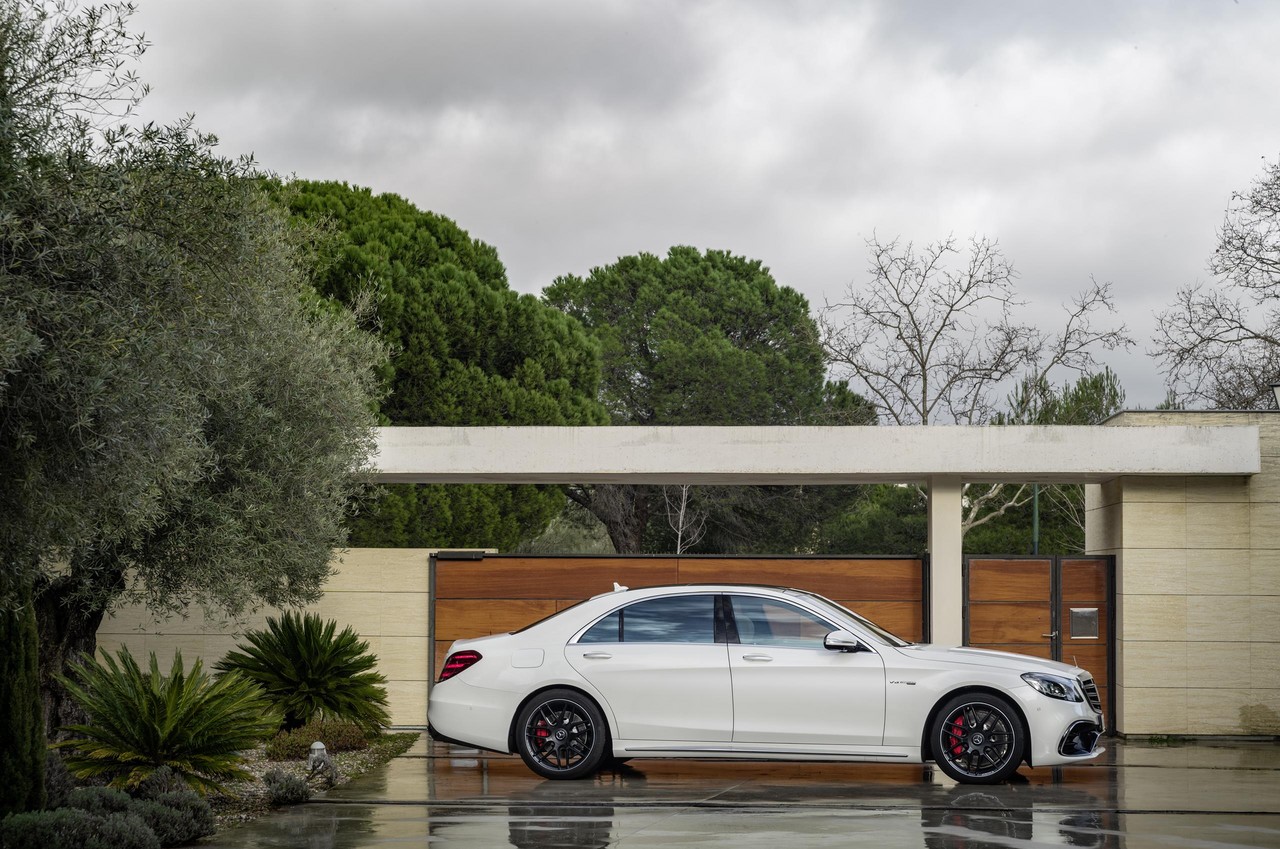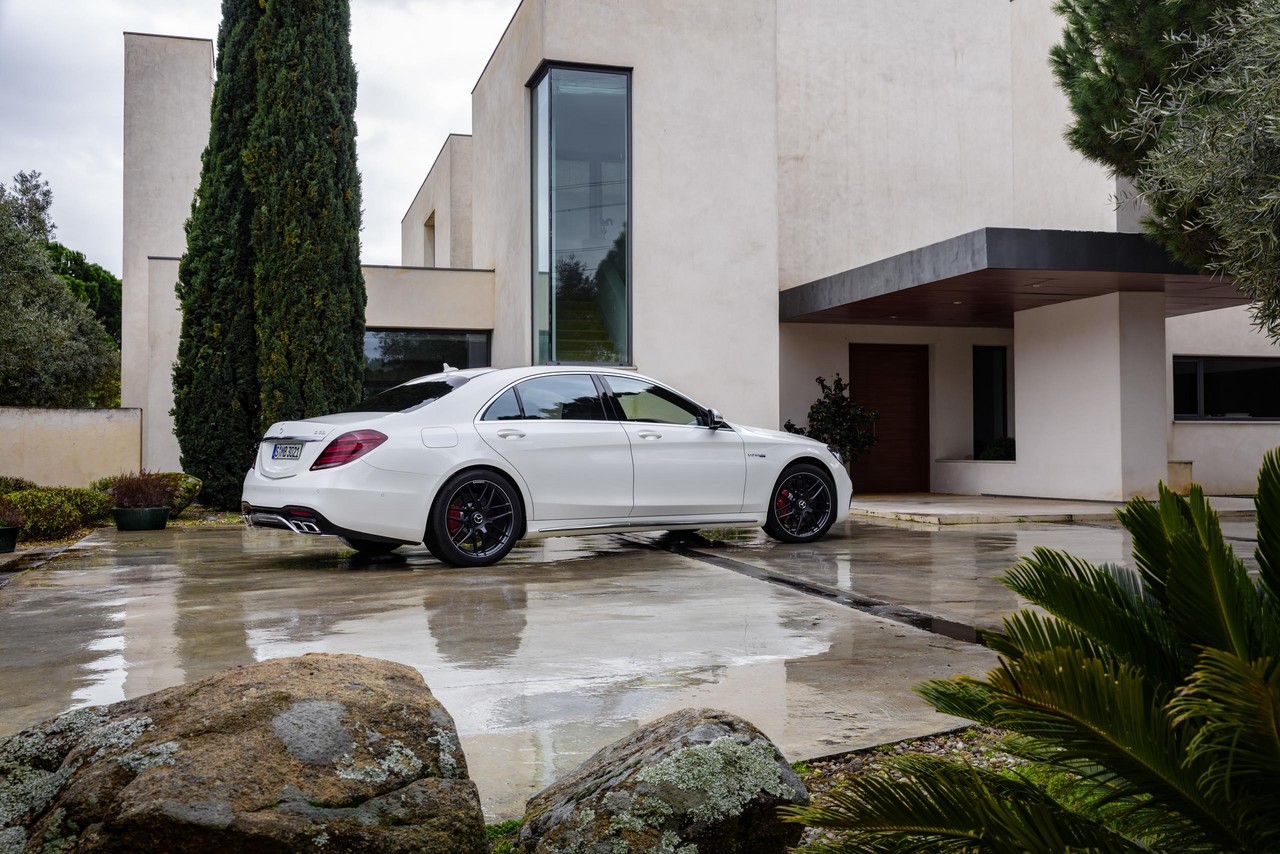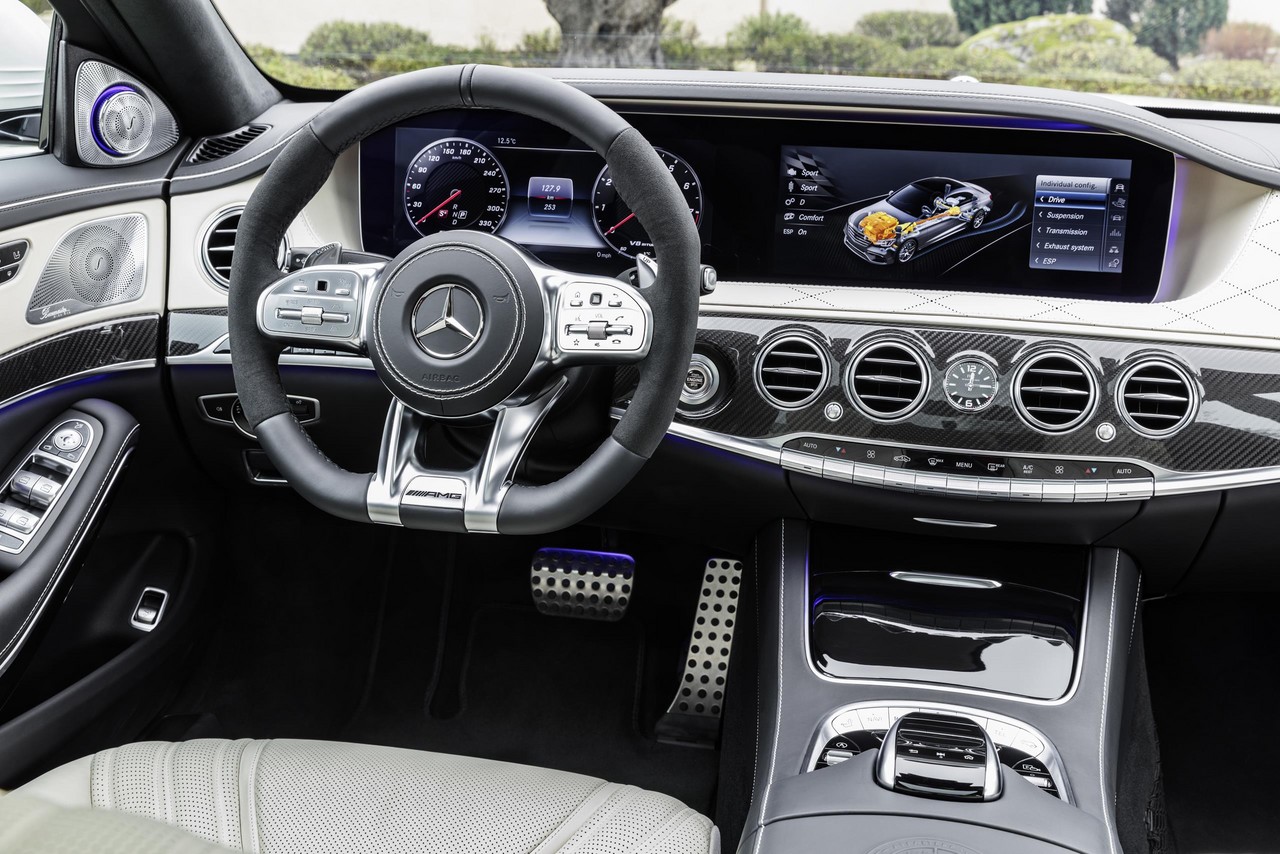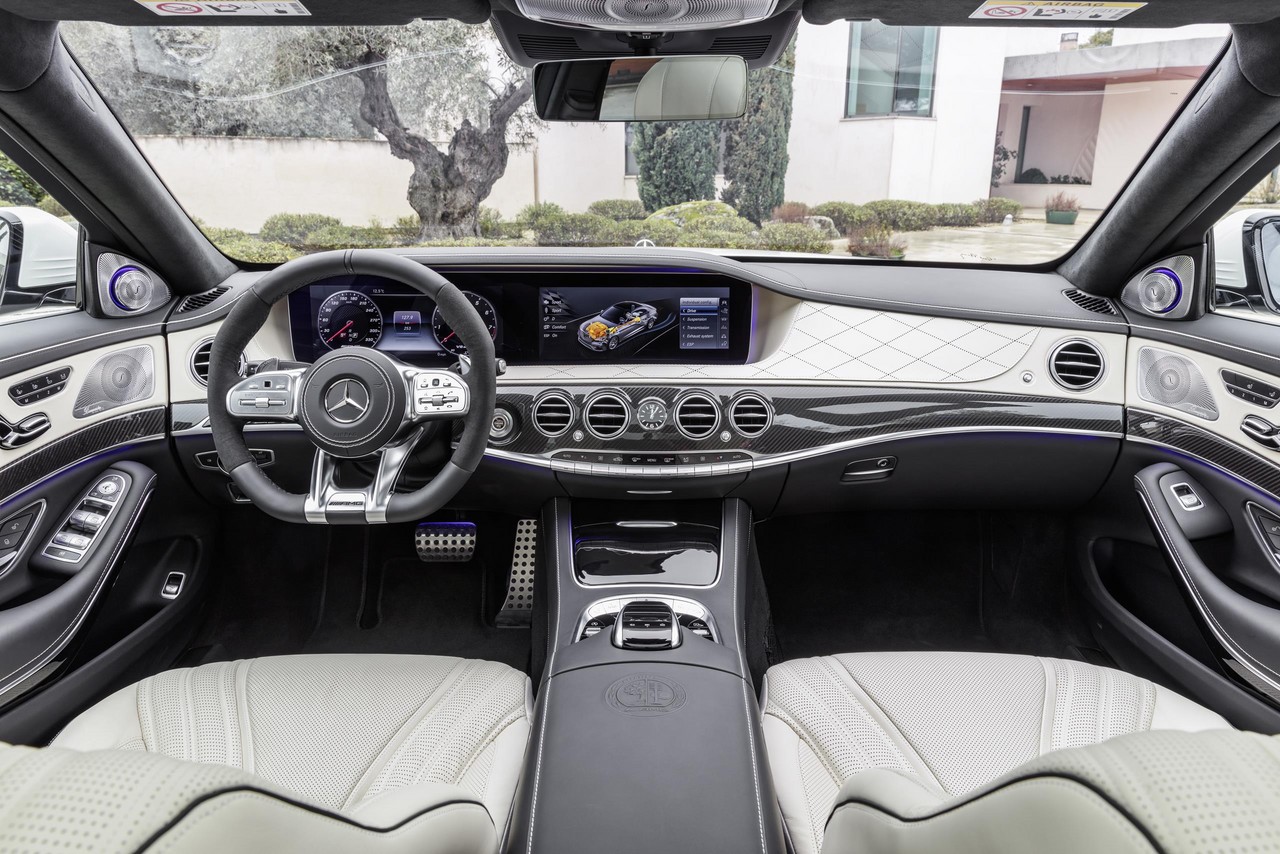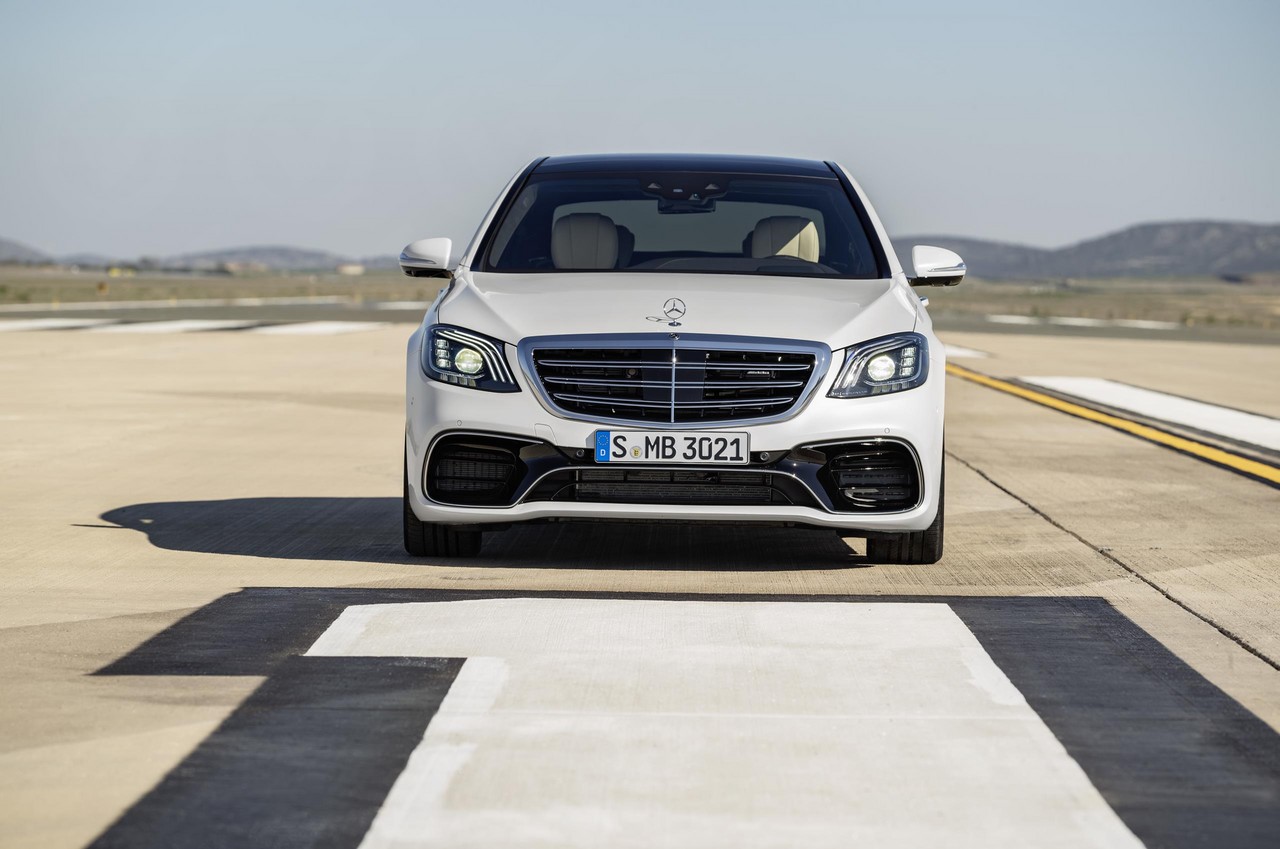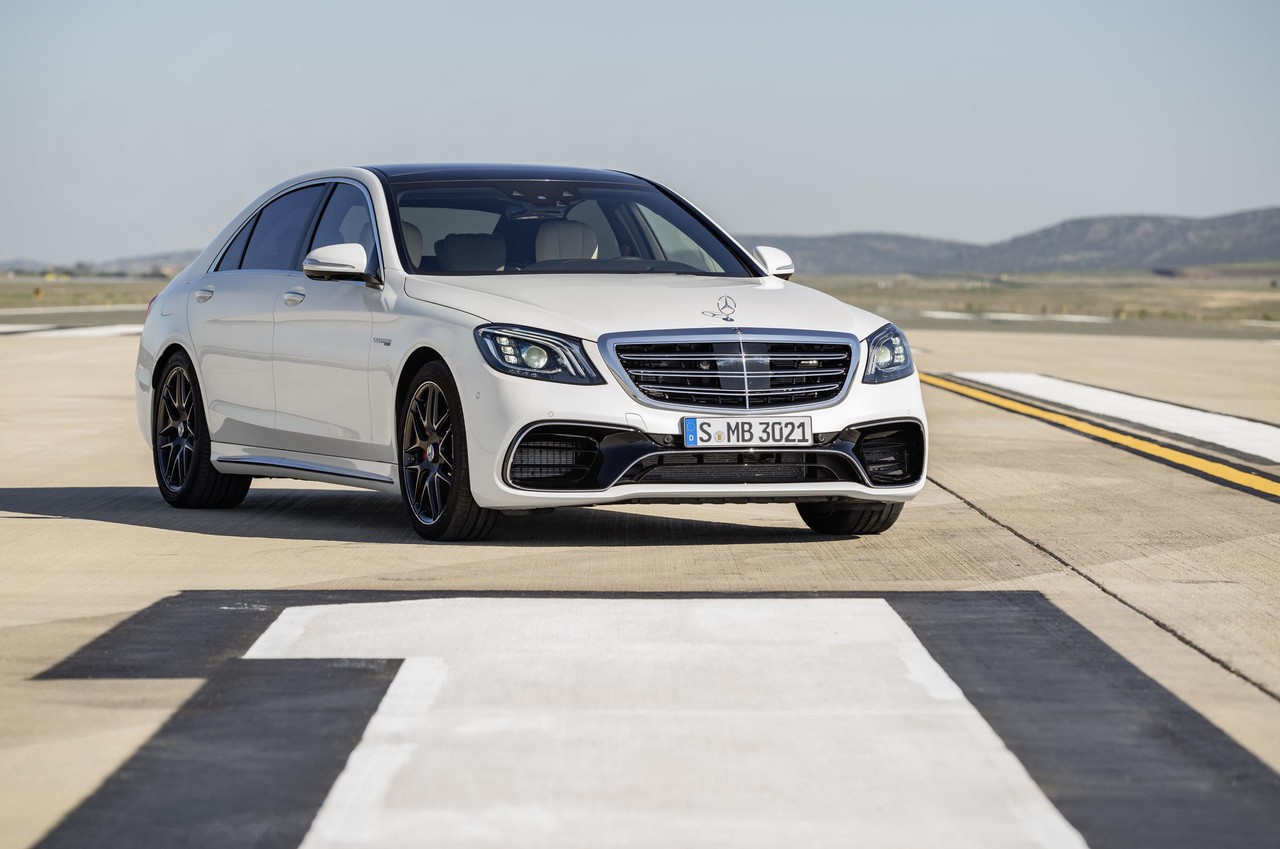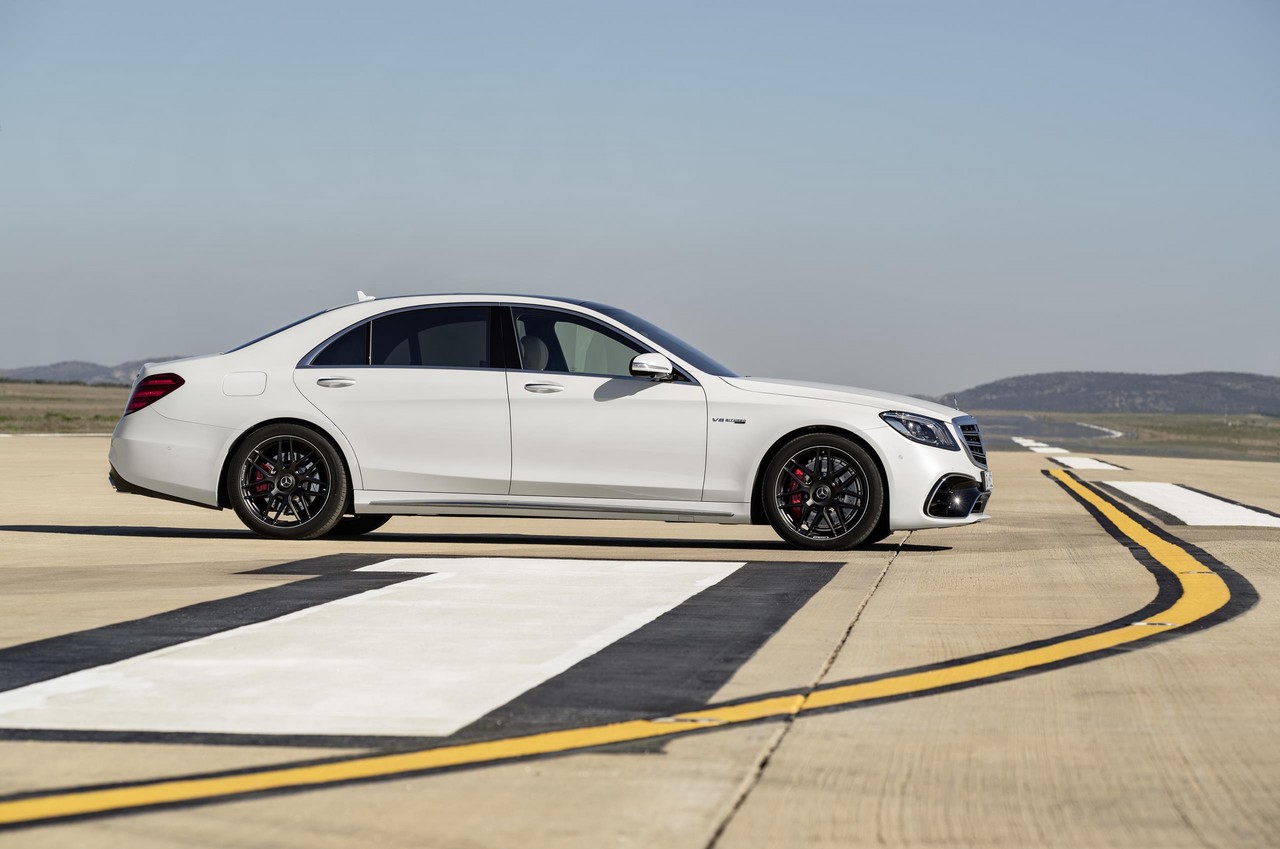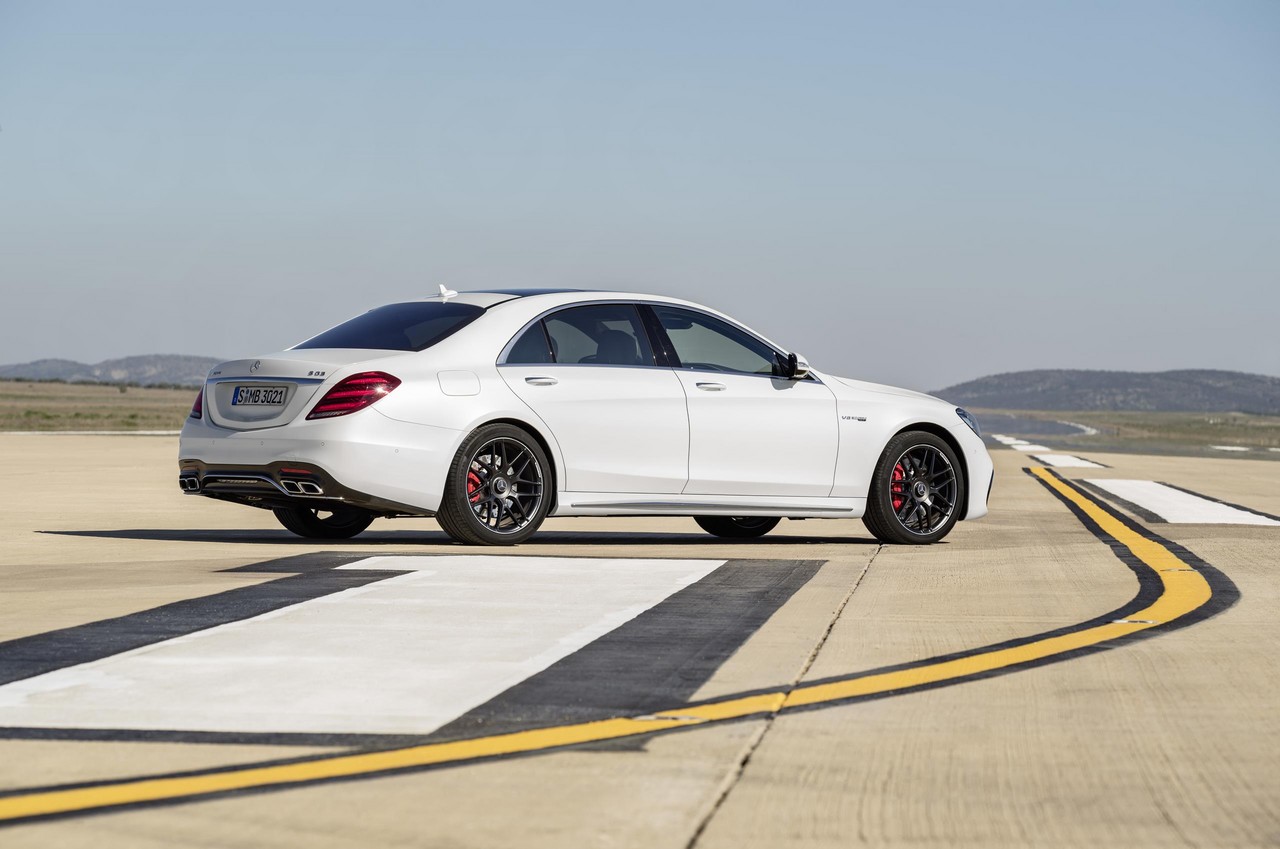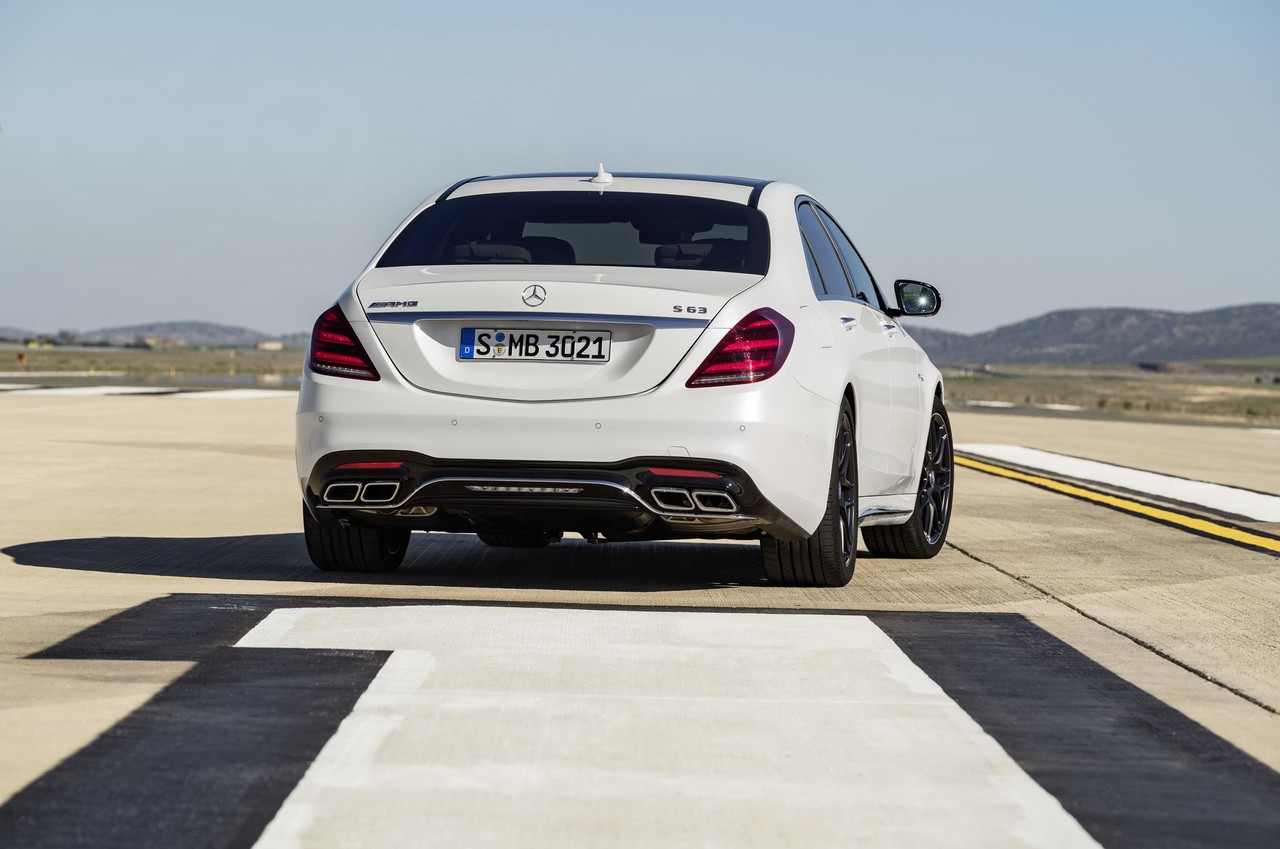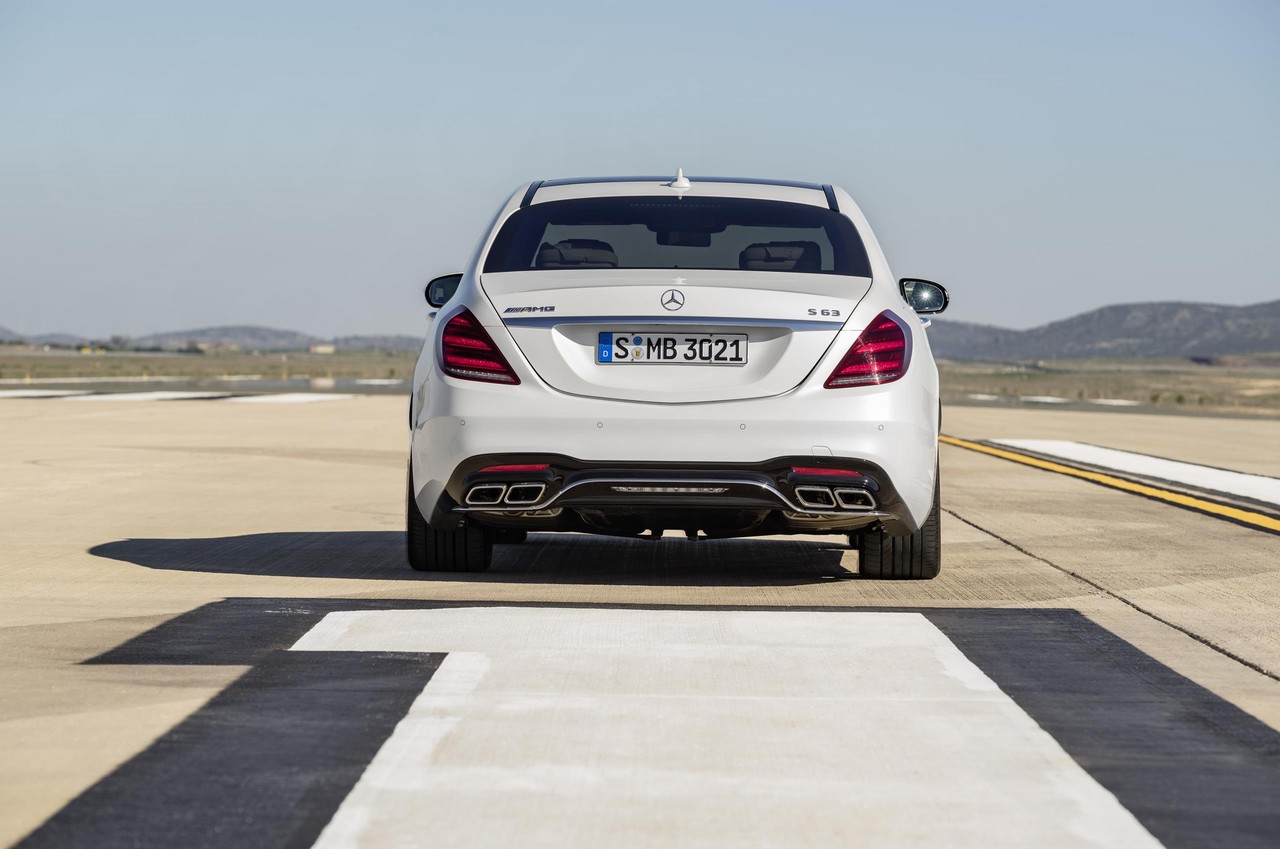
- Inconsistently weighted steering
- AMG Speedshift MCT can provide jerky gearshifts at low speeds
- High running, maintenance and depreciation costs
Review: Mercedes W222.I/V222.I S 63 and S 65 AMG (2014-17)
Overview
The Mercedes-Benz W222 and V222 S 63 AMG were released in Australia in February 2014, with the V222 S 65 AMG following in early 2015. Manufactured in Sindelfingen, Germany, the rear-wheel drive S 63 AMG and S 65 AMG were powered by 5.5-litre biturbo V8 and 6.0-litre biturbo V12 engines, respectively.
Mercedes S 63 AMG: M157 biturbo V8 engine
The M157 V8 engine had an aluminium block with cast-in aluminium-silicon (Silitec) cylinder liners, forged crankshaft made of 38MnS6BY steel alloy (a combination of manganese, sulphur, boron and yttrium) with eight counterweights and rotating in five main bearings, fracture-split forged connecting rods, an aluminium cylinder head, double overhead camshafts (driven by three high-performance chains), variable intake and exhaust camshaft adjustment over a range of 40 degrees via four pivoting actuators, four valves per cylinder and a compression ratio of 10.0:1. Furthermore, the M 157 had a dry weight of 204 kg, maximum engine speed of 6400 rpm and Bosch MED 17.7.3 control unit.
Significantly, the M157 engine had spray-guided direct injection with piezo fuel injectors (operating at 100 to 200 bar on a demand-related basis), a Garrett MGT2260MSL turbocharger for each cylinder bank (welded to the exhaust manifold) and air/water intercooling. To minimise fuel consumption, the M157 engine had an ‘ECO start/stop system’ – which the driver could disable if desired – and multi-spark ignition whereby the spark plugs could fire multiple times during the combustion sequence for more efficient combustion.
The S 63 AMG could accelerate from rest to 100 km/h in 4.4 seconds and had an electronically-limited top speed of 250 km/h. Over the combined ADR 81/02 test cycle, fuel consumption was 10.2 litres per 100 km.
Mercedes S 65 AMG: M279 biturbo V12 engine
The 5980 cc M279 biturbo V12 engine had an aluminium alloy block with 82.6 mm bores and a 93.0 mm stroke, an aluminium alloy cylinder head, manifold fuel injection, a single overhead camshaft per cylinder bank, a one-piece chain drive, a forged crankshaft, forged pistons, twin turbochargers, an air-to-liquid intercooler, three valves per cylinder (two intake and one exhaust, the latter filled with sodium) that were actuated by aluminium roller rocker arms and twelve double ignition coils (for multi-spark ignition). Furthermore, the M279 engine had a compression ratio of 9.0:1.
To minimise fuel consumption, the M279 V12 engine had an ECO start/stop system which could shut down the engine when the vehicle was stationary in traffic. Over the combined ADR 81/02 cycle, fuel consumption for the S 65 AMG was 11.9 litres per 100 km. Furthermore, the S 65 AMG could accelerate from rest to 100 km/h in 4.3 seconds and had an electronically-limited top speed of 250 km/h.
| Engine | Trans. | Peak power | Peak torque | |
|---|---|---|---|---|
| S 63 AMG, S 63 AMG L |
5.5-litre biturbo petrol V8 (M157 DE 55 AL) | 7sp semi-auto | 436 kW at 5500 rpm | 900 Nm at 2250-3750 rpm |
| S 65 AMG L | 6.0-litre biturbo petrol V12 (M279 E 60 AL) | 7sp auto | 463 kW at 4800-5400 rpm | 1000 Nm at 2300-4300 rpm |
AMG Speedshift MCT and 7G-Tronic transmissions
For the S 63 AMG, the seven-speed ‘AMG Speedshift MCT’ (Multi Clutch Technology) had a compact, wet start-up clutch that operated in an oil bath rather than a conventional torque converter. For the S 65 AMG, however, the ‘AMG Speedshift Plus 7G-Tronic’ transmission had a conventional torque converter.
Both the AMG Speedshift MCT and 7G-Tronic transmissions were accompanied by steering wheel gearshift paddles and had four selectable drive modes:
- Controlled Efficiency, ‘C’, provided softer throttle response, early upshifts to minimise fuel consumption and smooth gearshifts;
- Sport, ‘S’, for greater throttle response, higher engine speeds before upshifting, disabled the ECO start/stop function and performed gearshifts in 150 milliseconds (i.e. 50 per cent faster gearshifts than ‘C’). In Sport mode, the engine could partially suppress cylinder by interrupting ignition and injection under full load for faster gearshifts; and,
- Manual, ‘M’, required shifting via the steering wheel gearshift paddles and could change gears in 100 milliseconds.
Other features of the AMG Speedshift transmission included:
- Automatic throttle-blipping on downshifts;
- A double-declutching function for multiple downshifts; and,
- Delayed gear shifting if a certain level of lateral acceleration was present, to prevent gearshifts when cornering.
Both the S 63 AMG and S 65 AMG had the same transmissions ratios, i.e. 4.38 (1st), 2.86 (2nd), 1.92 (3rd), 1.37 (4th), 1.00 (5th), 0.82 (6th) and 0.73 (7th), with a final drive ratio of 2.65.
Body and dimensions
Like the Mercedes-Benz W222/V222 S-Class , the W222/V222 S 63 and S 65 AMG had hybrid steel/aluminium bodies in which the proportion of aluminium exceeded 50 per cent. Relative to its W221 S 63 AMG predecessor, the W222/V222 body achieved a 47 per cent increase in torisonal rigidity (40.5 kN/degree versus 27.5 kN/degree).
Compared to the W221 S 63 AMG , the W222 S 63 AMG was 81 mm longer (at 5157 mm), 44 mm wider (1915 mm) and 28 mm taller (1501 mm), though wheelbase length was unchanged (3035 mm). Kerb weight, however, decreased by 25 kg to 2045 kg. For the V222 S 63 AMG L and S 65 AMG L, they had 130 mm longer wheelbases (3165 mm) and overall lengths (5287 mm).
Suspension
The Mercedes W222/V222 S 63 and S 65 AMG had four-link front suspension and multi-link independent rear suspension, both with air springs, monotube shock absorbers and anti-roll bars. Although the rear-wheel drive S 63 and S 65 AMG were not fitted with Mercedes-Benz’s ‘Airmatic’ air springs, they were equipped with:
- Mercedes-Benz’s ‘Active Body Control’ whereby the spring struts had hydraulic cylinders that could adjust the force in each spring strut individually to compensate for body lift, roll and pitch; and,
- Mercedes-Benz’s ‘Magic Body Control’ used a stereo camera with a range of 15 metres (‘Road Surface Scan) to detect bumps on the road ahead and use this information to prepare the suspension accordingly.
Steering
The Mercedes S 63 and S 65 AMG had electromechanical, rack-and-pinion steering with speed-sensitive power assistance.
Safety equipment
Standard safety equipment for the Mercedes W222/V222 S 63 AMG and S 65 AMG included dual front airbags, front and rear side airbags, full-length curtain airbags, ABS, electronic brake force distribution, brake assist, electronic stability control, traction control and front and outer rear seatbelts with pre-tensioners and load limiters. Furthermore, the reclining rear seat – where fitted – had an airbag under the seat cushion (a ‘cushionbag’) to prevent submarining effects in the event of a collision.
In addition to the anticipatory ‘Pre-Safe’ safety measures (such as priming of the brakes in emergency situations, tensioning the seatbelts and closing the windows), Mercedes-Benz’s standard ‘Pre-Safe’ technologies for the W222/V222 S 63 AMG and S 65 AMG also included:
- Pre-Safe Brake with pedestrian detection (autonomous emergency braking): using two 24 GHz sensors behind the front bumper which had a range of 30 metres and a 77 GHz radar which had a range of 200 metres, Pre-Safe Brake operated at speeds between 30 km/h and 200 km/h, and at speeds below 70 km/h if the vehicle was approaching a stationary queue of traffic. Around 2.6 seconds before the anticipated moment of impact, an audible warning would sound and a red warning would appear in the tachometer. Around 1.6 before the calculated impact, the first stage of Pre-Safe Brake would initiate partial braking autonomously with around 40 per cent of the maximum braking power (approximately four (4) m/s2); the Pre-Safe occupant protections system would also be activated. If the driver then applied the brakes, maximum braking force would be made available. If the driver failed to react, Pre-Safe Brake would – in its second stage – initiate autonomous emergency braking (i.e. maximum braking power) around 0.6 seconds before the unavoidable collision to reduce the severity of the impact. The pedestrian recognition function enabled Pre-Safe Brake to detect pedestrians when driving at speeds of up to 50 km/h;
- Pre-Safe Plus: could anticipate rear-end collisions and warn following traffic by flashing the rear hazard warning lights at high frequency; and,
- Pre-Safe Impulse: in the event of a collision, both front occupants would initially be pulled away from the direction of impact by their seat belts prior to the subsequent occupant deceleration (reducing the risk and severity of injuries in a frontal collision).
Further safety equipment – fitted as standard – included:
- Distronic Plus (adaptive cruise control with brake warning): an ‘adaptive’ cruise control system which used two short-range radar sensors positioned behind the front bumper to monitor the road up to 30 metres ahead, and a long-range radar located behind the radiator grille which had a range of 200 metres. Operating at speeds up to 200 km/h, Distronic Plus used an electronic control unit to analyse the information from both radar systems to calculate the engine, automatic transmission and braking parameters required for proximity control. As such, Distronic Plus could automatically apply the brakes to prevent the vehicle from becoming too close to traffic ahead (the time interval could be specified) and accelerate back to the set speed when traffic allowed. To accelerate from rest, the driver only needed to operate the Distronic stalk on the steering column or briefly depress the accelerator pedal. With Distronic Plus, automatic deceleration of up to four (4) m/s2was possible. If Distronic Plus detected that heavier braking was required, a warning light would illuminate in the instrument cluster and be accompanied by an audible warning. Furthermore, the electronic proximity control system could be activated independently of Distronic Plus at speeds over 30 km/h to alert the driver if they were approaching another vehicle too rapidly;
Steering Assist with Stop&Go Pilot: operating in conjunction with Distronic Plus and at speeds up to 130 km/h, Steering Assist used a stereo camera located behind the windscreen to detect road markings, while the Stop&Go Pilot operated at speeds up to 60 km/h and enabled the system to use the vehicle in front or road markings as a means of orientation. If the vehicle was detected to be drifting out of its lane, Steering Assist would warn the driver and provide steering intervention to keep the vehicle in its lane; - Cross-Traffic Assist: could operate at speeds up to 72 km/h and used the stereo camera and radar sensors to detect traffic that was crossing in front of or behind the vehicle. If detected, the driver would receive visual and audible alerts;
- Active Blind Spot Assist: active at speeds above 60 km/h, a corrective braking force would be applied to the wheels on one side of the vehicle if the driver attempted to change lanes when a vehicle was detected in the driver’s blind spot;
- Active Lane Keeping Assist: would vibrate the steering wheel as the vehicle approached a continuous lane marking line and, if crossed, automatically brake wheels on one side of the vehicle to return the vehicle within the lane;
- Crosswind Assist: could detect sudden, strong gusts of wind and prevent the vehicle from drifting out of its lane via corrective braking forces on one side of the vehicle; and,
- Attention Assist with drowsiness detection: operated at speeds in excess of 80 km/h and assessed driver behaviour (including steering movements) for signs of drowsiness; if detected, the driver would be provided with visual and audible warnings.
The Mercedes S 65 AMG L was also fitted with Mercedes-Benz’s ‘Night View Assist Plus’ which could alert the driver to the hazards of pedestrians or animals in unlit areas ahead of the vehicle by automatically switching the instrument cluster from displaying the speedometer to an generated by a thermal camera which highlighted hazards. Furthermore, a spotlight function could flash any pedestrians detected ahead to warn them of the vehicle’s approach.
Brakes: S 63 and S 65 AMG
The Mercedes S 63 AMG and S 65 AMG had high performance composite AMG braking systems with 390 mm by 36 mm front brake discs and 360 mm by 26 mm rear discs.
Features: Mercedes S 63 AMG and S 65 AMG L
Standard features for the Mercedes S 63 AMG included 20-inch five-twin-spoke AMG alloy wheels, a 590 watt Burmester surround sound system with thirteen speakers, a nine channel digital sound processing (DSP) amplifier, digital radio (DAB+), a CD/DVD player, auxiliary inputs (USB/iPod/SDHC), a 10 GB Media Register, Mercedes-Benz’s COMAND system with a 31.2 cm high-resolution display, satellite navigation with 3D maps, DVB digital TV tuner, integrated WLAN hotspot, ‘Linguatronic’ voice control, touchpad, Bluetooth mobile phone connectivity and audio streaming, dual-zone climate control air conditioning (‘Thermotronic’), Nappa leather upholstery, AMG multi-contour front seats, power adjustable front and rear seats with memory settings, heated and ventilated front and rear seats, cruise control with variable speed limiter (‘Speedtronic’), LED headlights with Mercedes-Benz’s ‘Intelligent Light System’, automatic headlights, rain-sensing wipers, front and rear parking sensors, four cameras for 360 degree surround views, a two-spoke AMG sports steering wheel with Dinamica trim, remote central locking, proximity key with push-button start (‘keyless go’), power windows, power adjustable and heated door mirrors with folding function, a power adjustable steering wheel (for height and reach), memory settings (for the front seats, steering wheel and door mirrors), a panoramic glass sunroof, a power closing function for the doors, ambient lighting, illuminated vanity mirrors, laminated glass, AMG pedals with rubber studs, an IWC design analogue clock, illuminated stainless steel door sill panels, Dinamica sunvisors and roof lining, black poplar high gloss wood trim, tyre pressure monitoring system, a trip computer, an alarm system and an immobiliser.
As standard, the S 63 AMG was also fitted with Mercedes-Benz’s ‘Active Parking Assist’ system which could identify suitable parallel parking spaces – when traveling at speeds of up to 36 km/h – and autonomously steer the vehicle as the driver reversed towards the parking space.
The Mercedes S 63 AMG L was further equipped with four-zone climate control air conditioning, ‘Easy Adjust’ luxury head restraints for the front occupants and a rear seat entertainment system, a power-operated rear windscreen roller blind, and luxury rear head restraints with pillows.
Features: Mercedes S 65 AMG L
Compared to the Mercedes S 63 AMG L, the S 65 AMG L added a 1540 watt Burmester High End 3D Surround Sound system with twenty-four speakers and twenty-four amplifier channels, a six-disc CD/DVD changer with ‘Splitview’ display function, Exclusive nappa leather upholstery with contrasting stitching, ‘chauffeur’ position for the front passenger seat, multi-contour rear seats, a head-up display, convenience telephony, integrated garage door opener and ‘Magic Vision Control’ which directed water onto the windscreen via channels in the windscreen wiper blades to keep the windscreen clean.
The S 65 AMG L also featured an ‘Air-Balance’ package which provided perfume atomisation, ionisation and more efficient air filtration.
Brochure
Related links
- Press Kit: Mercedes-Benz W222 S 63 AMG (September 2013)
- Specifications: Mercedes-Benz W222/V222 S-Class (March 2014)
- Specifications: Mercedes-Benz W222/V222 S-Class (July 2014)
Review: Mercedes-AMG V222.II S 63 L (2017-20)
Overview
Production of the Mercedes-AMG W222.II/V222.II S-Class commenced in July 2017 and it was released in Australia in October 2017. For Australia, the V222.II S-Class range consisted solely of the S 63 L, which was powered by Mercedes’ new 4.0-litre M176 biturbo V8 petrol engine and drove the rear wheels via the ‘AMG Speedshift’ MCT 9-speed transmission.
For the Mercedes-AMG S 63, the M176 engine had two twin-scroll turbochargers positioned inside the engine’s ‘V’. To reduce fuel consumption, the M176 engine had –
- Cylinder deactivation: at partial loads, cylinders 2, 3, 5 and 8 were deactivated to reduce fuel consumption. When the ‘Comfort’ transmission mode was selected, cylinder deactivation was available at engine speeds from 1000 rpm to 3250 rpm;
- An ECO start/stop function which could shut down the engine when the vehicle was stationary in traffic; and,
- A sailing function (described under ‘AMG Speedshift MCT 9-speed transmission’, below).
Visually, the Mercedes-AMG V222.II S 63 L could be identified by its new multi-beam LED headlamps and updated front apron with jet wing. At the rear, the V222.II S 63 L had ‘crystal-look’ tail lamps with LEDs and three horizontal pairs of fibre optics, a new rear apron with diffuser insert and model-specific dual tailpipes for the AMG sport exhaust system.
Inside, the Mercedes-AMG V222.II S 63 L featured two new high-resolution displays – each of which had 12.3-inch (diagonal) screens – that shared a glass cover. In another development, the steering wheel had touch-sensitive controls that responded to swiping motions (like a smartphone) and could be used to control the infotainment system.
| Engine | Trans. | Peak power | Peak torque | |
|---|---|---|---|---|
| S 63 AMG L | 4.0-litre M176 biturbo petrol V8 | 9sp MCT | 450 kW at 5500-6000 rpm | 900 Nm at 2750-45000 rpm |
AMG Speedshift MCT 9-speed transmission
The nine-speed ‘AMG Speedshift MCT’ (Multi Clutch Technology) had multiple clutches that were placed together and controlled separately. Furtheromre, the AMG Speedshift MCT had a compact, wet start-up clutch that operated in an oil bath rather than a conventional torque converter; unlike double clutch transmissions, the AMG Speedshift MCT had a single input shaft. Features of the AMG Speedshift transmission included:
- Automatic throttle-blipping on downshifts;
- A double-declutching function for multiple downshifts;
- A ‘sailing’ function. When the driver released the accelerator at speeds between 60 km/h and 160 km/h, the clutch of the MCT could open to decouple the engine from the powertrain. Furthermore, electronics reduce engine speed to idling level and motion resistance was reduced by the compression and frictional forces of the engine in overrun mode; and,
- A ‘Race Start’ function.
Suspension
For the Mercedes-AMG V222.II S 63 AMG L, the ‘Road Surface Scan’ was improved by using the stereo camera system to scan the road more thoroughly, even in dusk and at speeds up to 180 km/h.
Previously introduced in the Mercedes-Benz C217 S-Class Coupe , the ‘Magic Body Control’ suspension had a curve-tilting function that could tilt the body of the vehicle towards inside of a turn by up to 2.65 degrees to reduce centrifugal forces perceived by the passengers. Active at speeds from 15 km/h to 180 km/h, the curve tilting function shifted the base point of each individual strut to allow the vehicle to incline.
Safety equipment
For the Mercedes-AMG W222.II/V222.II S-Class, ‘Distronic Active Proximity Assist’ makes use of map and navigation data to monitor driving behaviour and adjust vehicle speed. Other safety technologies include –
- Active Emergency Stop Assist: can bring the vehicle to rest when Active Steer Assist is engaged and the system recognises that the driver is not intervening in the driving process on a sustained basis; and,
- Active Lane Change: tapping the indicator stalk can initiate a lane change within ten seconds if no vehicles are detected in the relevant safety zone.
Features: Mercedes-AMG V222.II S 63 L
New features for the Mercedes-AMG V222.II S 63 L included –
- New Multi-beam LED headlamps with Ultra Range High Beam (the latter provided brightness in the main beams above the reference value of 1 lux over a distance of more than 650 metres);
- ‘Energizing comfort control’: integrated various comfort systems in the vehicle – such as climate control, ambient lighting, massage and fragrancing functions – and allowed the owner to configure settings for six program names: Freshness, Warmth, Vitality, Joy, Comfort and Training;
- Apple CarPlay and Android Auto smartphone integration for the COMAND Online infotainment system; and,
- Wireless charging for mobile devices.
For a complete list of features for the Mercedes-AMG V222.II S 63 L, please refer to ‘Specifications’, below.
Specifications
